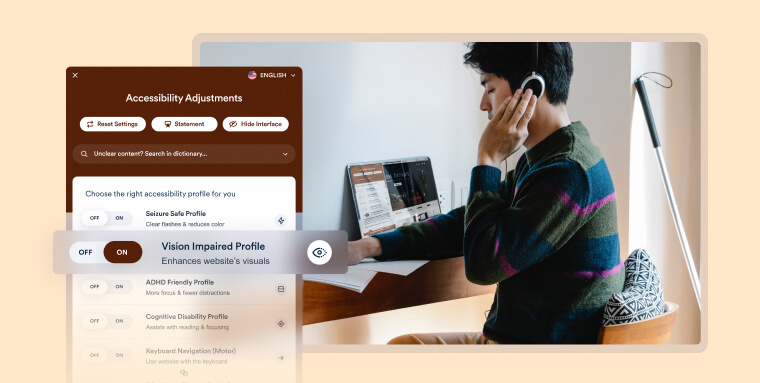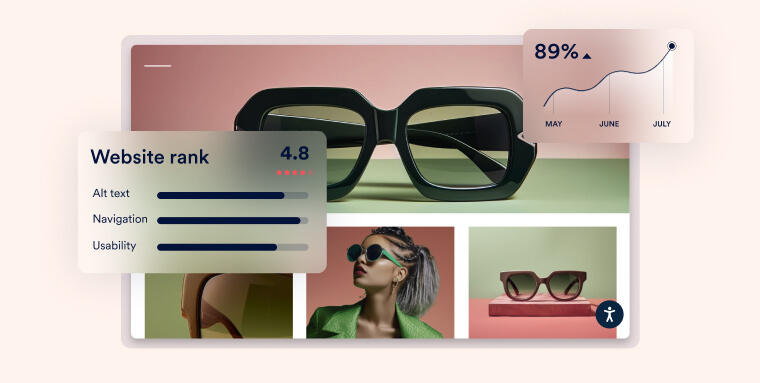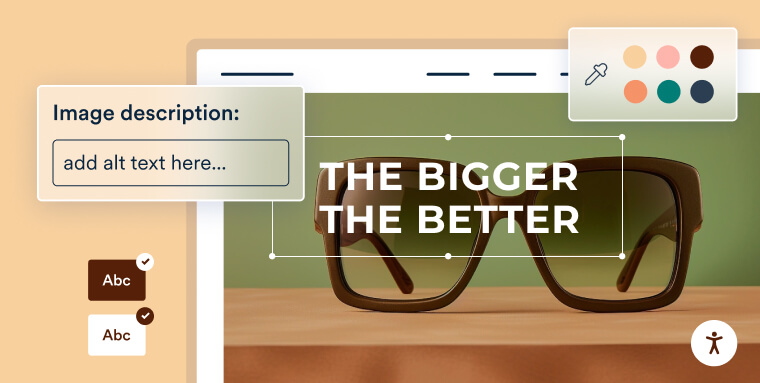The top five reasons web accessibility is critically important
With digital interaction becoming the norm, the imperative for web accessibility is clearer than ever. Here are five compelling reasons why ensuring your website is accessible is important:
- People with disabilities deserve fair and equal access to websites
- Accessible websites reach a wider and more diverse audience
- Accessible design benefits everyone, not just people with disabilities
- Web accessibility comes with significant SEO benefits
- Compliance with disability legislation is essential
Let's break each of these down in detail.
You can press on each bullet point to skip straight to it.
1. People with disabilities deserve fair and equal access to websites

The world continues to shift online. Even industries notorious for their reluctance to embrace technological trends now primarily serve and approach customers and clients via websites and/or apps.
In many cities around the world, riding a bus requires access to designated apps — a staple of modern transportation companies. Government agencies now routinely direct citizens to websites to complete important bureaucratic tasks.
If they are not designed with people with disabilities in mind, these websites and apps deny these people access to these vital resources and opportunities.
Healthcare, a critical service, hinges on web accessibility. With the rise of telehealth, particularly post-COVID-19, the healthcare industry has seen a massive shift to online platforms. Telehealth usage is now 38 times higher than before the pandemic, as reported by McKinsey. This dramatic increase underscores the need for accessible online healthcare services, so that everyone, including those with disabilities, can manage their health needs.
The move to online services is not limited to necessities. It extends to leisure and social activities as well. For example, if a movie booking site lacks clearly labeled buttons, screen reader users may not be able to get tickets. This prevents them from being able to enjoy entertainment like everyone else can.
Finally, education's shift to digital platforms — especially highlighted during the COVID-19 pandemic — starkly revealed the disparities. Students with disabilities not only faced educational hurdles but social isolation, as well, when platforms were not designed with accessibility in mind.
Bottom line: Accessible websites enable people with a variety of disabilities to properly participate in everyday life. This should be the primary motivating force to ensure your website is fully accessible.
2. Accessible websites have a wider reach and broader audience

By ensuring web accessibility, your business taps into the various disability communities’ massive spending power — over $13 trillion annually. This is not just a niche market. It is a substantial and growing segment that can boost your revenue.
On the flip side, ignoring accessibility, as highlighted by McKinsey, can be costly. Companies with inaccessible websites are losing approximately $6.9 billion a year to competitors who prioritize accessibility.
Furthermore, web accessibility aligns with a welcoming brand image, resonating with socially conscious consumers and employees.
In today's market, where brand values and customer experience are paramount, accessibility stands as a key differentiator. It's an investment in ethical responsibility and business growth. This approach is supported by studies like the Accenture report, which links a commitment to accessibility with positive outcomes like remarkable financial returns.
3. Accessible design benefits people outside various disability communities

Making your website design accessible is a crucial ethical step. Yet, the impact of accessibility extends far beyond the various disability communities.
Many web accessibility best practices lead to a better user experience for everyone.
High-contrast layouts improve readability for all website visitors, not just those with vision impairments. It makes content more legible and engaging, especially in environments with varying light conditions. This consideration in design can mean the difference between a user staying on your page or leaving due to readability issues.
Captions are another feature that extends its usefulness beyond the disability community. Many users, particularly younger ones, often watch videos on mute. Captions come in handy for them to understand the content. They can also help viewers in noisy environments or those who are not native speakers of the video's language.
Finally, mobile responsiveness, a core tenet of accessibility, is equally critical. In 2023, around 96% of people used their mobile phones to access the internet, globally. This percentage has likely grown since, as mobile technologies become more readily available. Having a mobile-friendly website helps you cater to a larger user base and deliver a seamless experience across varied devices.
4. Web accessibility has significant SEO benefits

An accessible website will likely rank higher in search results, improving its overall SEO performance. A collaborative study by Accessibility Checker, Semrush, and Builtwith covered 847 websites, revealing a compelling finding:
73.4% of sites that improved their accessibility also saw an increase in organic traffic.
So, how exactly do accessibility best practices go hand-in-hand with SEO? Here are a few examples:
- Alt text helps users with vision impairments understand the image while guiding search engines in recognizing and categorizing visual content
- Video captions help users with hearing impairments grasp critical information while giving search engines valuable keywords and content to index (therefore enhancing your multimedia SEO)
- Structured content, like using clear headings, simplifies navigation and interpretation for both human readers and search engines
For a more in-depth breakdown on the relationship between web accessibility and SEO, press here.
5. An accessible website is essential for complying with disability legislation

Several laws protecting people with disabilities from discrimination apply to websites. Therefore, ensuring your website is fully inclusive is not merely a moral imperative. It is often a legal requirement, as well.
Let's break down some of the most prominent laws you should be aware of:
The Americans with Disabilities Act (ADA)
The Americans with Disabilities Act (ADA) broadly applies to businesses deemed 'public accommodations.'
In recent years, U.S. courts and the Department of Justice have extended this definition to the online domain. This means that the ADA applies to websites and mobile applications, with WCAG routinely referenced as the benchmark for accessibility under the law.
Given that most businesses serve the public, they fall under the category of 'public accommodations.' Therefore, they must comply with the ADA. This includes ensuring their websites and online content are accessible in line with WCAG standards.
We recommend you take a look at our comprehensive checklist for achieving ADA website compliance by pressing here.
Section 508 of the Rehabilitation Act
Section 508 of the Rehabilitation Act requires certain organizations to make their information and communication technology (ICT) accessible to the disability community. ICT is a broad term that applies to various hardware and software and includes websites and web-based applications.
You need to comply with Section 508 if you are:
- A federal agency
- An organization that receives federal funding
- A service provider to one of these organizations
If Section 508 applies to you, you will need to ensure your website conforms to WCAG 2.0 Level AA.
We recommend you take a look at our comprehensive checklist for achieving Section 508 website compliance by pressing here.
Accessibility for Ontarians with Disabilities Act (AODA)
The Accessibility for Ontarians with Disabilities Act (AODA) requires public and private organizations in Ontario, Canada to make their services accessible to people with disabilities. Under this law, Ontario-registered organizations need to ensure their websites conform to WCAG 2.0 Level AA.
If this law applies to you, we recommend you take a look at our comprehensive checklist for achieving AODA website compliance by pressing here.
European Accessibility Act (EAA)
The European Accessibility Act (EAA) focuses on accessibility in digital services across Europe, with an emphasis on websites and online platforms. It affects a range of sectors, including online retail, telecommunications, and banking services. Private businesses, especially those providing services to European government agencies, must also adhere to the EAA's accessibility standards.
The EAA does not specify detailed technical standards for compliance. However, it aligns with the EN 301549 standards, which follow WCAG. This means businesses are expected to make their web content accessible according to these guidelines.
Even though web accessibility is not mandated just yet, all relevant entities within the EU must meet the EAA's standards by June 28, 2025. This deadline demonstrates the need for prompt action by companies to ensure their digital offerings are accessible to all users.
Web accessibility: charting the course for inclusivity online
Web accessibility is more than meeting technical requirements — it is a vital ethical commitment. Here, we have highlighted its importance, not just as a legal necessity but as a moral imperative for equal access.
This commitment extends beyond complying with legislation like the ADA, AODA, and Section 508 (if these apply to you). The goal, ultimately, is to ensure everyone, including people with disabilities, can access and engage with online content.
Making your website accessible transforms the digital experience into a welcoming space for all. It is a testament to your brand's dedication to inclusivity. Continuous web accessibility efforts yield practical benefits, such as a larger reach and enhanced user engagement.
Frequently asked questions about the importance of web accessibility
Q1. Why is web accessibility important for businesses?
A1. Web accessibility ensures that people with disabilities can interact with your website without barriers. When businesses make their digital experiences accessible, they welcome more users, strengthen brand trust, and contribute to a more inclusive online world.
Q2. How does web accessibility support people with disabilities?
A2. Accessible websites provide alternatives, structure, and clarity that assist people who use screen readers, rely on keyboard navigation, need captions, or benefit from clearer layouts and content. These adjustments help users access information independently and consistently.
Q3. Does web accessibility affect user experience for everyone, not just people with disabilities?
A3. Yes. Clear navigation, readable text, logical structure, and predictable interactions improve usability for all visitors. Many accessibility practices overlap with strong UX design and help create smoother experiences across devices and environments.
Q4. How does the ADA relate to web accessibility?
A4. The ADA is the civil rights law that requires businesses to provide accessible digital services. Although the ADA does not specify a technical standard, many organizations rely on WCAG guidelines to help align their websites with the accessibility expectations associated with ADA compliance.
Q5. Why is WCAG so important in accessibility discussions?
A5. WCAG is the most widely recognized set of guidelines for making digital content accessible. While it is not a law, it provides clear criteria for designing websites that are perceivable, operable, understandable, and robust for users with diverse needs.
Q6. Does improving accessibility help reduce legal risk?
A6. Strong accessibility practices can demonstrate your commitment to supporting users with disabilities and may help mitigate legal risk. Although accessibility cannot eliminate the possibility of legal complaints, ongoing improvement shows a clear intent to provide equitable access.
Q7. What are some common accessibility issues found on websites?
A7. Many websites encounter issues such as missing alt text, insufficient color contrast, unlabeled form fields, inaccessible PDFs, and components that cannot be navigated with a keyboard. Addressing these issues improves usability for a broad range of visitors.
Q8. Is web accessibility a one-time project or an ongoing process?
A8. Accessibility is ongoing. New pages, content updates, design changes, and platform updates can introduce fresh challenges. Regular testing and maintenance are essential to keeping your website accessible over time.
Q9. Why do many organizations invest in accessibility beyond legal requirements?
A9. Accessibility supports brand reputation, increases customer reach, and demonstrates a meaningful commitment to inclusion. It is both a compliance expectation and a strategic business advantage.
Q10. How can accessiBe help organizations improve their website’s accessibility?
A10. accessiBe offers end-to-end accessibility solutions that combine advanced AI, human expertise, and developer tools. Through solutions like accessWidget, accessFlow, and professional remediation services, organizations can identify issues, improve accessibility, and support their efforts toward meeting ADA and WCAG expectations.







